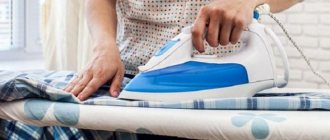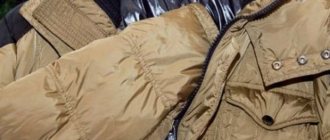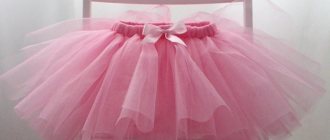Organza is a real festive fabric that looks fabulous and beautiful. It is airy and weightless, so it is perfect for creating a wedding dress and veil, elegant and sophisticated evening dresses, and theatrical outfits.
Organza is widely used to create curtains, curtains and canopies for beds. Thin transparent fabric gives lightness and airiness. It will decorate any interior, make the lighting pleasant, soft and uniform. Organza is used to decorate halls, make ribbons and bows, flower arrangements and decorations.
Despite its lightness and transparency, organza is quite rigid, durable and elastic. It holds its shape well, but requires special care. It is important to follow the washing and ironing regime, otherwise the material will quickly deteriorate and become deformed. In this article we will learn how to iron organza without harming the material.
Material characteristics
Organza is a transparent and thin, hard and elastic airy material that is obtained by twisting viscose, silk or polyester fibers. This is a strong and durable fabric that retains its shape well and does not wrinkle. The soft, smooth and cool material is very pleasant to the touch. It has the following characteristics:
- High strength, rigidity and reliability. Such fabric is difficult to tear;
- Weightlessness and transparency, high light transmission. It transmits light, making it uniform and soft. Therefore, organza is actively used to sew curtains;
- Holds any shape, retains its original size and appearance, looks elegant and luxurious. Therefore, it is suitable for creating a fluffy wedding dress and skirt, theatrical costume or veil;
- Resistance to organic solvents;
- Practicality and crease resistance. The even and smooth fabric does not wrinkle and remains neat and tidy.
Organza is made from viscose, polyester and silk. The first two options are the most accessible. After processing, the fabric can be shiny or matte, can shimmer in different shades, have patterns or be plain. In addition, embroidery is done on organza.
Is it possible to remove wrinkles without an iron?
Is it possible to iron organza without using an iron? This question is asked by many housewives who are afraid of ruining too delicate fabric. In fact, there are a couple of methods that can help you remove creases. True, you will need to put in a little effort here, since such work is more demanding and delicate. The easiest option is to let the fabric hang a little after washing by hanging the curtains on a curtain rod. But this option will not work if you washed the curtains incorrectly, for example, by turning on the spin mode.
Be sure to place a cloth on the floor to prevent drops of water from dripping onto the floor and forming puddles. Stretch out large “wrinkles” with your hands, but try not to stretch the fabric too much so as not to tear it.
In other cases, you can use a steam generator. Wait for the product to dry, hang it on the curtain rod and get to work. Remember when we said that you need to be careful when handling products with steam, because yellow stains may appear? To prevent this from happening, make several passes when steaming.
How to properly care for organza
It is better to wash organza items by hand. To do this, select the appropriate detergent for a given type and color of fabric, dilute it in warm water and soak the product for two hours. After this, rinse lightly, straighten the material and leave to dry under natural conditions indoors or outdoors.
By the way, organza is resistant to various solvents and chemicals. Therefore, if the white material has faded, turned gray or yellowed over time, you can use bleach, but without chlorine. Oxygen formulations would be a suitable option. When and how to use whiteness, see here.
In addition, you can bleach fabric by soaking the item for 6-8 hours in salted cold water. To prepare the solution, use two teaspoons of salt per five liters of water.
Products without embroidery, beads, flowers, beads and other decorative details can be washed in a washing machine. Be sure to remove removable elements before water procedures. For washing, choose liquid detergents, shampoos and gels. Set the delicate mode with a temperature of up to 40 degrees with a spin of up to 500 revolutions or without spin.
Lightly wring out washed items. Organza should be dried in a vertical position. Curtains and bulk items are hung on a rope, clothes are hung on hangers. It is important to carefully straighten and smooth the material with your hands and leave it to dry away from batteries, sunlight and electrical appliances.
The result depends on the wash
Following the rules will greatly simplify ironing. There should be no hot water or intense spinning, which can cause creases.
Recommendations:
- Use only warm water up to +40” to prevent “bubbles” from appearing.
- Place the product in a washing bag or pillowcase, which will protect the material from lint and snags.
- For machine use, turn on the “delicate” mode.
- The fabric will wrinkle less if the spin is limited to 400-500 rpm.
- When washing by hand, do 2-3 rinses to wash out the powder, which will make the fabric softer.
- Spinning in a machine, like twisting, is better replaced by natural drainage of water in a suspended state.
- Powder or gel is suitable for washing.
- When the fabric is still damp, begin ironing. This way, it will be easier to straighten out the bruises.
Important! Washing without spinning is the best solution for organza. So, it does not wrinkle and, in most cases, smoothes out on its own when wet.
Rules for ironing organza
If you dry your organza correctly, no ironing is needed. However, in some cases it is important that the material looks perfect. For example, you need to iron a wedding dress or evening dress. After washing, organza should only be ironed when slightly damp. When the water has drained, begin the process.
Be sure to check the label before the procedure. There are instructions for care, follow these requirements! When ironing, set the iron to the minimum heat temperature and turn the item inside out. Place the item on a thick cloth, such as a towel. Cover the top of the product with gauze, tissue paper, cotton or other thin fabric.
Use only the minimum ironing temperature, otherwise yellow marks or even burnt areas will remain on the material. It is better not to iron dresses and skirts with a lot of folds, but to wash them without spinning and hang them on hangers in the room or in the fresh air. Leave the product until completely dry.
A safe solution to smooth organza is steaming. Run a steam generator or an iron with a vertical steam function over the material, holding the device at a distance of 15-20 centimeters from the fabric. In addition, you can hang clothes over a bathtub or a container of boiling water. It is important that the hem of the product is at some distance from the water. Steam treatment will smooth and clean the material, eliminate folds and creases, and remove dust and stains.
How to iron organza after washing?
In general, the quality of ironing is largely influenced by the washing process. For example, the water should not be too hot, and the spin mode should be turned off - if you wash it in a machine, set it to the delicate mode. Some housewives, wanting to reduce work time, iron organza without washing it. If there is dust or dirt on the fabric, under the influence of hot temperature it will penetrate even deeper into the fabric.
Tip: pay attention to the soleplate of the iron - it must be clean. If you notice carbon deposits or stains, be sure to clean them.
If you have tissue paper available, great! With its help, ironing will be even better than through fabric.
Interesting!
The bed linen should be “crispy” and perfectly ironed - just imagine how comfortable it will be to sleep on it! But many housewives do not iron their products because they think that this is a complex and necessary process. But this is far from the case - we will tell you how to iron bed linen so as not to waste precious time on it.
Chiffon is no less delicate material than organza. And that’s why it’s so important to know how to iron it, so as not to damage the fabric by improper actions. Here you will find all the secrets to successfully ironing fabric.
How to iron organza curtains
Ironing curtains made of organza or tulle is difficult, since it is a large and long material. This is not necessary. You can wait for the water to drain after washing and hang the curtains on the windows to give the desired look. Organza will dry out in a short time and will collapse under its own weight.
To iron long curtains, place the ironing board next to the sofa or chair. Place a piece of fabric on the board and begin smoothing. Once you have ironed the desired section of tulle curtains and it reaches the floor, transfer the material to the sofa and gradually move the board away. Continue ironing, gradually moving the fabric in this manner. Wide curtains can be ironed by folding the material into several layers.
When ironing, press the iron against the fabric, but do not hold it in one area for too long. Iron each area several times, especially if the curtains are folded in layers. During the process, do not use hot steam, otherwise the organza will ripple. For more information on how to iron organza tulle and other fabrics, read the link.
Tips and prohibitions
The following tips will help you avoid ironing mistakes:
- Wrinkles can be easily removed by ironing them through damp gauze.
- The temperature regime for organza never exceeds 140 C.
- Organza is ironed intensively, but without strong pressure. Thin, light matter, even if the iron is held in one place for a minute, can change color and structure.
- Strong creases and folds can be effectively removed using a steamer. Exposure to steam is carried out at a distance of at least 15 cm from the material.
- Before ironing, always test the heated iron on an inconspicuous area of the fabric. Particular attention is paid to the first ironing of organza products.
Please note: light, airy organza quickly loses its strength, shape, and appearance if the ironing temperature is incorrectly chosen or the steam generator is not used correctly.
How to iron tulle without an iron?
If you don’t have an iron, or unforeseen circumstances arise, there is another option. How to iron tulle without an iron?
- Using a steam generator. To iron the fabric using this method, it must be hung along its entire length, eliminating any unevenness. It is necessary to treat the entire area of the canvas with a steam generator, and if necessary, more than once. To do this, simply move the nozzle at a distance of 0.5-1.5 cm from the curtain.
You can straighten curtains while hanging using any steam generator with a vertical operating mode. - Using a spray bottle. For the second method we need a spray bottle. The washed fabric is hung on the cornice, under the influence of its weight it straightens, unevenness is smoothed out, and wrinkles are eliminated. Your task is to monitor the quality of the material, spray it with water from a spray bottle if external defects remain.
Any handheld spray bottle will work for this method. - Using boiling water. To do this, hang the canvas over a bathtub, which is 1/3 filled with hot water and leave overnight. Boiling water will smooth out all the unevenness on your curtain.
The importance of washing mode
Many ironing problems can be avoided by washing organza correctly.
- Temperature
In pursuit of whitening or crystal clarity, you can easily forget that synthetics cannot withstand high temperatures. And if we are always on the alert with the iron, then when washing we can without hesitation set the temperature to 50° or 60°, while the maximum for organza is 40°. Synthetics washed in too hot water have a damaged structure, which when drying creates unevenness that cannot be smoothed out with an iron! The synthetic thread will “float”, and nothing will return it to its former length and width, so set the parameters on the machine very carefully before starting washing. She must be very delicate.
- Handwash
Still, the best option would be to wash the curtains by hand, because this is not a very labor-intensive process that will allow you to completely control the situation.
- Spin
It is important to remember that you cannot press organza with your hands, and you can only set the machine to the lowest speed possible. The spinning process also affects the safety of the thread structure, so it is not recommended to neglect this advice.
Advice
For even more gentle washing, place the curtains in a special laundry bag. You can even use a pillowcase! This way, the thin fabric will not come into direct contact with the drum of the machine, which will greatly reduce the risk of snags, stains and other types of deformation.
Conclusion
The images that can be created with organza curtains are very beautiful, and it would be foolish to abandon their attractiveness just because of the hassle associated with caring for the material. The fabric is quite practical, does not fade, does not collect dust and does not need cleaning for a long time. With high-quality weekly cleaning, you will have to wash organza no more than 2-4 times a year.
Improper care of the curtains quickly leads to their wear, and it will no longer be possible to restore the attractiveness of the curtains. In order for curtains to last for many years and maintain their aesthetics, you need to give them due attention and provide high-quality non-aggressive cleaning on your own or with the help of professionals.
Related article: Playhouse for children: step-by-step photos, diagrams, drawings
Description of fabric
Tulle is a weightless fluffy fabric that serves as a raw material for production in many industries. This is due to its structure, which is represented by a simple grid or pattern. It is one of the most popular materials, it's all about its versatility. Tulle curtains will add lightness and tranquility to the interior, and clothing elements will give it an interesting design.
Nowadays, curtains made of synthetic fabrics are the most popular.
Today, manufacturers are ready to offer tens of thousands of ideas for the design of windows and doorways, but modern housewives still prefer patterned tulle. This is justified; tulle curtains can maximally change the decoration of your apartment: visually add space to it, hide external defects. Thanks to the homogeneous structure of the matter, the following conditions for caring for it have developed:
- In order for a product made of tulle material to avoid unwanted color, it must be washed frequently;
- Before machine washing, the product must be freed from dust and various types of deposits;
- This fabric should never be soaked in hot water - it may shrink; it is recommended to soak the fabric for 3-4 hours in lukewarm water with soap or soda solution;
During the soaking process, the tulle must be turned over periodically. - You can dry or iron the fabric only in the straightened position;
- You cannot forcibly wrinkle, rub or tug the tulle. the structure of the canvas is very thin, if you carry out such manipulations with it, it will very quickly lose its external qualities;
- curtains are a material that does not require ironing; you can simply hang it in a slightly damp position.
Important! If you wash tulle in a machine, you must choose a mode that does not include spinning, so as not to damage the fabric!
The main thing when machine washing tulle is to choose the right mode.











